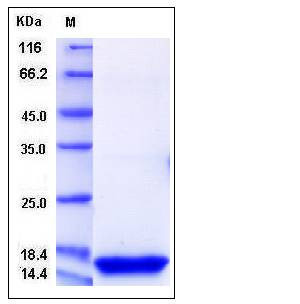Mouse REG3D Protein (His Tag)
INGAP,Ingaprp,MGC130575,Reg3d
- 100ug (NPP2784) Please inquiry
| Catalog Number | P50540-M08H |
|---|---|
| Organism Species | Mouse |
| Host | Human Cells |
| Synonyms | INGAP,Ingaprp,MGC130575,Reg3d |
| Molecular Weight | The secreted recombinant mouse REG3D comprises 160 amino acids and has a predicted molecular mass of 18.5 kDa. rmREG3D maigrates as an approximately 17 kDa band in SDS-PAGE under reducing conditions. |
| predicted N | Glu 27 |
| SDS-PAGE |  |
| Purity | > 97 % as determined by SDS-PAGE |
| Protein Construction | A DNA sequence encoding the mouse REG3D isoform 1 (NP_038921.2) extracellular domain (Met 1-Gly 175) was fused with a polyhistidine tag at the C-terminus. |
| Bio-activity | |
| Research Area | Cancer |Invasion microenvironment |Adhesion molecule |Cell adhesion |Lectin |C-tyep lectin | |
| Formulation | Lyophilized from sterile PBS, pH 7.4 1. Normally 5 % - 8 % trehalose and mannitol are added as protectants before lyophilization. Specific concentrations are included in the hardcopy of COA. |
| Background | Regenerating islet-derived 3 delta (REG3D) is a member of the secreted Reg superfamily and contains one typical C-type lectin domain. Regenerating gene (Reg), first isolated from a regenerating islet cDNA library, encodes a secretory protein with a growth stimulating effect on pancreatic beta cells. Reg and Reg-related genes which were expressed in various organs have been revealed to constitute a multigene family, the Reg family, which consists of four subtypes (types I, II, III, IV) based on the primary structures of the encoded proteins of the genes, which are associated with tissue repair and have been directly implicated in pancreatic beta-cell regeneration. Reg proteins are expressed in various organs and are involved in cancers and neurodegenerative diseases. They display a typical C-type lectin-like domain but possess additional highly conserved amino acids. |
| Reference |
